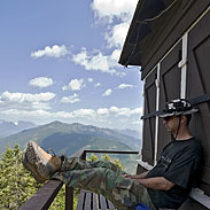Landscape Architecture for Landscape Architects › Forums › GENERAL DISCUSSION › Is America too safe?
- This topic has 1 reply, 7 voices, and was last updated 16 years ago by
 Landon Davidson.
Landon Davidson.
-
AuthorPosts
-
July 13, 2009 at 11:45 pm #173778
 Chris WhittedParticipant
Chris WhittedParticipantAnd now we really get to it, because I think liability is the core issue for the whole matter. Briefly, regarding the land use side of things, I LOVE the inherent danger = attracitve nuisance thing and I can’t wait for the day a lawyer refers to the Grand Canyon or other park as such. Actually, I suppose that already happens since some areas are ‘closed to the public’.
But on the design side you pose the real question of where is the line? Within the past few years here locally, a couple of kids were playing in your normal, run of the mill detention/retention pond during a heavy rainstorm and one drowned. Now the entire thing, which used to be at least a passive amenity for the neighborhood/apartments, is completely chainlink fenced off. Public water features are one of the biggest magnets for this subject; they’re usually posted keep out because of it. Two of the most recent community parks here have had their water features shut down (only one of which I heard specifically was for liability, the other or both may actually have been maintenance issues). Both were intended for kids to play in and didn’t hold water so much as spray it, but it made for potentially slick surfaces and when the second kid fell… One of these same parks has the first (that I know of) mountain bike obstacle course, which I was positively shocked to see despite it being fenced, gated, and signed. At first I thought it was for dogs! And I will note we have three skate parks and a BMX dirt track as part of those and other parks.
Is it the fault of the designers of these places? Is it the fault of the owners/maintainers? Is it the fault of the users (or their guardians)? Where do you draw that line? Stepping out of the house (even staying in it!) offers the thread of bodily harm or death. I believe that we’ve simply gone too far to the fear of litigation and lack of personal responsibility and accountability in everyday design and life. Running that trail next to a 30′ dropoff without a guardrail or even signs? Probably not a good idea. A fountain kids can play in, even well posted that surfaces may be slick? Sounds very reasonable to me. I’m still waiting to see a lawsuit over injuries resulting from a skateboarder trying to slide a rail and running into one of those anti-board bands (or other similar products and situations).
It’s not really a question of promoting danger as a planned experience so much as defining what is dangerous, and for who. I think it comes down to what is a reasonable expectation of safety in design (and the appropriate context), and unfortunately ‘reasonable’ is open to interpretation and opinion. Because of that, we must design to an ever-increasingly lower/higher standard so that no one can find something ‘unsafe’.
July 14, 2009 at 2:28 am #173777 Chad CrutcherParticipant
Chad CrutcherParticipantAs a trampolinist, I watched attorneys assault my sport because so many foolish people who did not take the time to understand the apparatus got seriously hurt. I could have, too, but the difference is I prepared myself with proper training. In the public realm, we cannot expect all to be properly prepared or even physically capable of addressing whatever inherent danger may exist. I think the conversation has floated a bit too far from being realistic. The real answer to your initial question might be, no it is not too safe…yet, the attorneys are still workin’ on it. The deeper question is how can we address the rabid penchant for tort litigation (read: ambulance chasing). Problem is, we would all want to be able to get blood out of a stone if we were the injured party.
Ever heard the story about the City of Pleasanton, CA paying big bucks to settle a lawsuit brought by a motorcyclist who, upon running when the cops tried to pull him over for a traffic violation, lost control during the chase as he tried to make a turn at high speed, hit a wet patch of street (at 3AM) caused by irrigation overspray and was injured?
Or, how ’bout the one where an architect in St. Louis who, while waiting for his bus to work, observed an unsafe condition at a construction site that his firm was not in any way involved with…and he said nothing to anyone. An injury resulted and somehow the parties in the case learned this guy had observed the unsafe condition and said nothing. Because he was a licensed architect, he was found to share in responsibility for the injury and was liable for a portion of the damages!!! Be careful. Be very, very careful.
July 14, 2009 at 2:35 am #173776 Mike TupaParticipant
Mike TupaParticipantAh, Nick, Glad to hear you also joined “the group” of privilaged among those of us who have been pulled over by the res’ patrol. Me, on jet ski having fun while the wife is on the pontoon of friends. I motor up to say hi-ask if she would like to ride, and I get pulled over because I was following too close, another time just to make sure I had the appropriate license (it wasn’t my jet ski), flags, flairs, whistle, etc. Oh, yes, and another because we were pulling a couple others on one of those inflatable bouncing fun things with the jet ski, yep, pulled over because 1) we pulled them out through the marina and 2) because we couldn’t fit the 2 others on the jet ski? So he made us pull them to the nearest shoreline, (can’t return through the marina after all) and run back and forth to return the inflatable, then pick up each as they hung onto rocks and twigs at lakes edge, freezing, till we could get them all back to shore.
I wonders: does their stewardship remove my liability? I don’t think it made me or others safer.No tickets or fines. Seems a white mustash gives me a bit of latitude.
I know this isn’t LA related but is a good point about stewardship, responsibility, enforcement and our preception of responsibility withiin the environment we all live within.
July 21, 2009 at 10:01 pm #173775 Roland BeinertParticipant
Roland BeinertParticipantMy senior project in college was on the dutch shared street called a woonerf. The idea, for anyone who hasn’t heard of them, is that streets are safer when everyone (pedestrians, bicyclists, drivers) shares the entire street, as long as cars are not allowed to go more than about 16 mph. The separation of sidewalk and street is often only a visible separation (no curbs). Obstacles (traffic calming, parked cars, playgrounds, trees, etc.) are put in street to keep drivers at a reasonable speed. Obviously, a woonerf doesn’t extend too far, so that drivers don’t get too frustated. (here’s a wikipedia article on these concepts: http://en.wikipedia.org/wiki/Shared_space )
The project brought about some interesting conversations. Often I was told that it would never work here in the US. Some suggested they could only possibly work as alleys. It was a very alien concept to some.
I’m bringing this up, because I wonder if our ideas about safety in this country are too limited to regulations and laws. There are other factors involved like the perception of safety and danger and the presence of other people. I guess in remote locations, like recreation areas or large parks, maybe it is important to have regulations, since other people are scarce and people are doing things sometimes partly for a sense of danger and to test themselves. But in more populated areas, maybe we need to look at the role of other factors.July 21, 2009 at 11:28 pm #173774 ncaParticipant
ncaParticipantI’ve missed out on the last week or so of replies on this thread because I was out dangling myself off mountain sides, fording rivers, and sleeping in remote wilderness.
Anyway, I think everyone brought up great points. The question stands, where is the line?
Roland, you once again bring up a great point regarding perception. I think perception plays a key role in the way America continues to build public places. I believe the rampant overuse of litlgation (ambulance chasing and the subsequent rules, laws, regulations) in America is degrading the innate ability of Americans to determine ‘real’ vs. ‘perceived’ dangers.
Sterilization of public (and private) space is making the human organism fat, dull, and dopey. Is there a way, as designers who undoubtedly have some influence on shaping the places in which we live, to juxtapose this pattern in ways that are not directly harmful to the public?
July 22, 2009 at 6:48 pm #173773 Roland BeinertParticipant
Roland BeinertParticipantI think the lawyers are just taking advantage of a situation where people have a freedom to do anything, anywhere, and no one is ever there to make them think twice. To a large extent, the freedom to do what we want is a good thing. It’s just that people need to understand there are boundaries. Since the boundaries aren’t apparent, people do stupid things. Since they were just excercising their freedom, the lawyers can point to someone else and say it’s his fault for not making the danger clear. This fingerpointing then makes us designers afraid to include elements in a design that might make people think twice about doing something stupid, like street trees or playgrounds in the middle of a woonerf. It’s kind of a positive feedback loop.
Vitality and safety in public space, unfortunately, seems to have as much to do with the context of the space as the design of the space. You need a mix of uses around a space so that people have a reason to use the space at all times of the day. That’s why some really well designed places go under-utilized. Jane Jacobs (yes, I’m bringing her up again) devoted a whole chapter of Death and Life of Great American Cities to public spaces, and it’s worth a read.
I suspect private space goes under-utilized, because we only use it for recreation. Recreation time is exactly the time when we are most prone to doing something stupid. People used to have things like outdoor summer kitchens, since they didn’t want to heat their homes up too much. These other uses drew adults outside where the kids were playing. -
AuthorPosts
- You must be logged in to reply to this topic.


